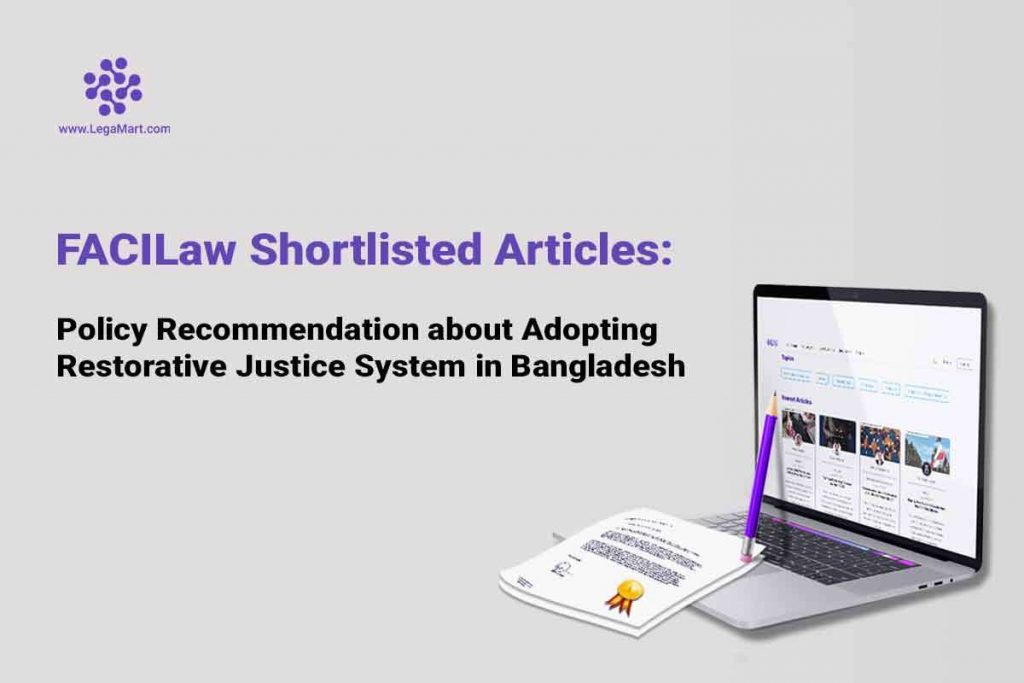This article is written by Anwar Hossain
Introduction
Resolving disputes outside the formal legal system in which both the parties (victim & offender) represent themselves personally or by a representative through a process of mutual compromise is known as restorative justice. It is a cutting-edge and pro-welfare movement in both victimology and criminology. Under this system, the victim and the offender signed a contract under which the offender agreed to compensate the victim for any losses and damages. Therefore, restorative justice programs allow the victim, the offender, and affected community members to be actively involved in responding to the crime.
As a result, they become a central part of the criminal justice process, with governmental and legal experts acting as facilitators of a framework that seeks to ensure that offenders are held accountable, that victims are made whole, and that the victim, the offender, and the community are all fully involved. Although village courts in Bangladesh have limitations and disadvantages, they still play a significant role in resolving disputes and preserving social peace and tranquillity in rural areas.
Purpose of Restorative Justice
- Restoring the victim to the pre-victimization condition
- Rehabilitating the offender
- Providing a less restrictive alternative to incarceration
- Deterring the offender from future criminal activity
- To make the offender understand the victim’s suffering
- To protect the victim from being double or multiple victimizations.
An important reason for adopting the Restorative Justice
Considering the present caseloads of our Lower and Higher courts, we will quickly understand that justice is not being received promptly and it takes so much time the famous maxim of William E. Gladstone, “Justice delayed is justice denied,” goes with such a situation. Therefore, a brief scenario has been shown below up to 2019. (N.B: Now these statistics go high as recorded in 2019.)
More than 35.82 lakh cases are now pending with the higher and lower courts across the country, according to statistics placed by the renowned English newspaper ‘The Daily Star’.
Pending Cases (Civil, Criminal & Others) (Total Cases 35,81,034)
- Appellate Division 21,813 Cases
- High Court Division 5, 06,221 Cases
- Districts Sessions Judge/Tribunals 30, 53,000 Cases
According to the figure mentioned above, recorded in 2019, the total pending cases in the Appellate division were 21,813 cases, in the High court Division 506221 cases, and in the District and Session Judge Courts were 30, 53,000 cases in Bangladesh. So, all these pending cases are creating huge backlog cases which deny proper justice procedures and question the accountability of laws.
Benefits of Restorative Justice
The restorative justice system offers the citizens faster, more private, cost-effective, time-saving, and long-lasting relief. In addition, it lightens the load on the legal system as a whole. The best solution, where both parties can cooperate to find a long-lasting resolution, can be reached through negotiation, where both parties are satisfied with the results.
More specifically, in a restorative justice system, the victim is given a chance to speak with the offender directly, receive real compensation for losses, and be forced to explain the offence to the offender, including why they were complicit in the crime and why they committed the crime against them.
As a result, victims are more likely to receive restitution through one of the components of restorative justice by getting answers from the offender than through the legal system. On the other hand, the offender can accept direct and personal responsibility, become aware of the effects of their actions, apologize and express regrets to the victim directly, and avoid the embarrassment of having a criminal record.
Recommendations for adopting Restorative Justice

There is no specific provision directly relating to restorative justice in Bangladesh’s legal system. Though ADR has been introduced briefly in the Code of Civil Procedure 1908, sections 89A, 89B, and 89C, it does not cover restorative justice in the fullest sense. Some of the recommendations that can be considered in adopting Restorative Justice include the scheme of compensation for Victims.
1. First, the most substantial Act regarding the protection of Victims and Witnesses should be enacted; otherwise, the victim and witness shall not inform the concerned authority, and thus the purpose of restorative justice will not be served because the victims feel insecure.
2. The attitude of different stages of the criminal justice system, like; Law enforcement agencies, Prosecutions, Courts, Prison and Correction centres, and parole Boards, should be more friendly, approachable, and prompt in their action.
3. As the concept of Restorative Justice is new in Bangladesh, the importance and the benefits of Restorative Justice must be clear to all otherwise, the state and stakeholders shall refrain from showing their interest towards adopting Restorative Justice with the existing legal framework.
4. Like the Village court within the limits of union parishad and the dispute Conciliation Board within the Limits of Paurashava, another semi-judicial mechanism can be introduced under the Victim Compensation Act Like Village Court Act 2006.
5. To settle a dispute under Restorative Justice, first of all, there should be a board like the board of the village court. The board must be neutral and hold the notion of a win-win strategy in the interest of true justice.
6. Here, the principles of natural justice must be maintained. Both parties must be heard (Audi Alteram Partem), and after a fruitful discussion, the board will reach an effective solution and make a contract between the disputing parties.
7. If the aggrieved party deem that they should go to another judicial body, he must have such opportunity to go to the District Judge court or other courts subordinate to it.
8. The decision of the board of restorative justice should be logical, reasonable and just, cost-effective and less time-consuming. Its decision should be accepted by the other judicial body so that the disputing parties might understand the value and effectiveness of such a decision and the would-be disputing parties come under such a judicial system.
9. Restorative justice as means of repaying victims should outline a provision that the victims who cooperate with the police and prosecutors incur additional losses of time and money for their trouble.

10. There should be a provision under Restorative Justice for the notion of rehabilitating offenders. Because, in some cases, victims do not want the criminal justice system to take revenge in their name. Victims are most likely to endorse treatment if their offenders are not strangers but lovers, family members, relatives, neighbours, classmates, or colleagues.
11. But there should be some punishment in the Restorative Justice System, which helps deter crime in society. First, the convicts should suffer incarceration to pay their debt to the community. Next, they should undertake strenuous efforts to repay the specific individuals.
12. Every Victim under Restorative Justice should get the assurance of their compensation, and the victims should also be informed of the time and procedure of getting such compensation.
13. If the offender is unable to pay restitution due to his financial condition, he should render a service to the victims and the community to compensate for the losses he caused to the victim and society. Here it is pertinent to mention that the state shall also provide compensation as the security must be maintained by the state under a social contract agreement.
14. Restorative Justice will design considering the plight and sufferings of the victim. It should be in the victim’s interest. But it should not hold the notion of injustice to the offender as it also believes in the offender’s rehabilitation.
Conclusion
As the formal Justice system in Bangladesh is under tremendous pressure for huge caseloads, Restorative Justice can be a useful tool to reduce such caseloads. It is an umbrella concept and social movement. Both civil and criminal matters can be solved under the restorative justice system like Village Court. For its lower cost, speedy disposal and known person come together with the justice process. Another vital reason is as the current criminal justice system does not aid offenders in understanding the repercussions of the crimes they commit.
It does not assist them in becoming law-abiding citizens. The court needs to address these problems to punish them. As a result, the offenders voice their disagreement with the legal system. Offender participation in the proceedings is essential to ensuring justice because it helps them understand how seriously their crimes have affected the lives of others. In addition to helping to heal the victims’ wounds, this realization will also help them to comprehend. So, to reduce the crime rate and establish peace in society, a restorative justice system might be an effective method.
That’s a wrap for this article!
To stay up-to-date on the latest legal developments in the local and international markets, check out LegaMart’s blog!




